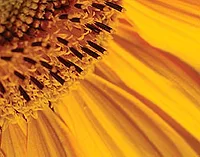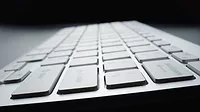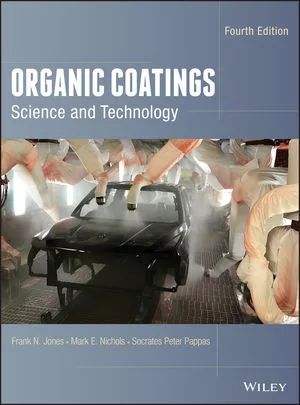Evaluation of Scratch Resistance Test Methods for Organic Coatings
Scratch resistance is not uniquely defined, and is difficult to measure. Different terminologies are used, ranging from marring for optical defects towards friction, wear, erosion, abrasion and cracking for mechanical defects.1,2 The scratch resistance can be evaluated in terms of gloss reduction, haze, magnitude of deformation, resistance towards deformation, weight loss or color change of the substrate.
The relationship between deformation and surface properties of both the scratch stylus and coated substrate is complex.3 Briscoe et al. proposed the concept of scratch mapping, a test procedure to map the scratch response to different conditions by varying contact load and contact strains.4,5 Nevertheless, this approach requires many experimental efforts.
The contribution of different deformation mechanisms determines the overall shape, magnitude and characteristics of the resulting residual deformation. A scratch can be the result of three deformation components: an elastic, a ductile and a brittle component.6-8 Several studies have been made describing the irreversible deformation processes present in polymers subjected to various wear tests.9-13 The plastic pile formation is crucial for the visibility of a ductile deformation.14 A brittle deformation, visible or not, always leads to reduction of the protective roll of the coating. The deformation response depends both on the contact conditions and the physical state of the material. In order for a coating to remain intact on the surface, cohesion in the bulk and good adhesion to the substrate are required. The scratch deformation mechanism is determined by the time-dependent properties of the polymer.12 Therefore temperature and scratch rate are very important whenever polymeric materials are involved. 14
Current scratch test methods differ widely in many aspects, making results difficult to compare. It is not totally clear whether any of the tests yield reliable results regarding in-service performance of a material. In this paper, different scratch morphologies and their test methods are described and evaluated. The influence of the chemical composition of a radiation-curable polymer on its scratch resistance is discussed.
Radiation-Curable Resins
A summary of the different radiation-curable resins described in this paper is given in Table 1. The urethane acrylates UA-1 - UA-6, as mentioned in the table, are already diluted with 30 parts of 1,6-hexanediol diacrylate (HDDA) in order to reach a processable viscosity. UA-6n contains 70 parts of an undiluted urethane acrylate (UA-6) and 30 parts of silica-reinforced HDDA. This low-viscous monomer, consisting of surface-modified synthetic SiO2-nanospheres, has a SiO2 content of 50 %. All coated samples are cured by electron beam (EB) at 5 Mrad, 200 keV and stored 24 hours in a conditioned room at 22 °C, 50 % RH prior to testing.Clemen Test
By pressing and drawing with a pencil on a coated substrate, a mark can be left behind, mostly seen as a groove accompanied by two lateral banks. This type of scratch is called ‘impression,' where the scratch dimensions are large in regard to the coating thickness. The scratch resistance is defined by the ISO 4586 standard as the minimum load applied to a pricker of defined geometry that produces a continuous mark, visible to the naked eye, at the surface of the coating. The applied load is successively increased or decreased in an attempt to determine the minimum critical load at which a scratch appears. The scratch resistance in this method is defined as the ability of a coating to resist an impression.The build-up of the banks is mostly determined by the geometry of the pricker. For example, a cube-corner stylus will give more piling-up than a sphere stylus for the same scratch width.4 As earlier described, the plastic pile formation is crucial for the visibility of a ductile deformation. The visual appearance depends on the incident light as well as the observation time. A material that is scratched will try to reduce its deformation by its visco-elastic behavior, or by the time-dependent visco-plastic relaxation. The plastic deformation depends on the temperature, but also on the substrate. The maximum threshold for an impression is mainly determined by the stiffness of substrate, as further shown in the test results.
In the Clemen test, a single, sphere tip indenter comes softly in contact with a coated substrate, making an impression of 6 cm at constant speed. The stylus is made of hard steel having a standard diameter of 1 mm. In order to be accurate, the stylus should be tested on a reference sample prior to use. The scratch resistance is defined as the minimum load applied to the stylus that produces a continuous mark.
The resistance towards impressions of six different resins was evaluated, as shown in Figure 1. The urethane acrylates were applied on glass at 40 µm thickness and EB cured. The scratch resistance was evaluated directly after scratching (visible scratch) and 24 hours later (permanent scratch).
By comparing UA-2, UA-4, UA-5 and UA-6, it can be seen that the functionality of the resin has an important influence on its resistance towards impressions. As mentioned before, the deformation depends on the time-dependent properties of a polymer. The deformation of the scratched resins can reduce in time due to the plastic relaxation, and eventually disappear. The visual threshold of the scratches on the UA-1-, UA-2- and UA-5-based coatings increases after 24 hours. The coatings based on the other urethane acrylates also show a reduction in scratch width, but the original scratches are still visible.
The Clemen test, carried out on a glass substrate, gives a better idea about the intrinsic properties of a polymeric coating. But the visual threshold of an impression is also influenced by the hardness of the substrate. Therefore, the different resins were applied on polycarbonate, which is much softer than glass. The scratch thresholds immediately after scratching and after 24 hours are shown in Figure 2. The visual and permanent scratch threshold for uncoated polycarbonate is 600 g, while that of glass is above 4000 g.
Only UA-1 is softer than the substrate. Due to its relaxation, the original scratches diminish, and some eventually disappear. The visual threshold for impression of the other resins is situated above this of the substrate, meaning that the permanent impression is equal to the visual one. Nevertheless, all coatings show a relaxation that can be seen by reduction of the scratch width. UA-2 and UA-3 perform much better on polycarbonate than on glass. The resins containing a polyester-based polyol perform better than those with a polyether polyol, as shown by comparing UA-1 and UA-3 with UA-2 and UA-4, respectively. Due to the low threshold for impression of polycarbonate, the higher functional resins cannot improve the scratch resistance that much. The limit of improvement of the resistance of polycarbonate towards impressions is reached at around 1000 gram applied on the scratch stylus with organic coatings. A slight improvement can be obtained using inorganic nanoparticles as shown by UA-6n. The hardness of the substrate plays an important role in the resistance of a coated sample towards impressions.
Taber Scratch Test
Fracture-type scratches can be produced with a taber apparatus (ISO 4586). The taber tester consists of a turntable, rotating at a fixed frequency of 5r/min. The load on the indenter, mounted on a horizontal arm, can be increased successively up to 500 g. The taber indenter consists of a hemispherical diamond point, with a point radius of 90 µm ± 3 µm and an included angle of 90° ± 1°.The resistance towards cracking is defined as the critical load at first cracking. The threshold of impression (scratch visibility) does not always correspond to the appearance of cracks. On carton or wood substrates, the cracks can be easily visualized by wiping the surface with a methylene blue/water saturated cloth. A microscope can be used to visualize the cracks on a coated plastic substrate.
Due to the dimensions of the test species required for the taber scratch test, not all substrates are well-suited. Therefore, we carried out the test on two easy, processable substrates - carton and polycarbonate. Again, the different resins were applied at 40 µm and EB cured.
The resistance towards crack formation of the different resins on carton is shown in Figure 3. UA-1 is a very flexible resin, but lacks toughness. It is therefore susceptible to crack formation. UA-5 and UA-6 are brittle resins that cannot follow the substrate during the deformation. They easily break at higher applied forces due to their hardness. After all, the substrate is very soft, and therefore impressed at very low pressure on the pencil. UA-2, UA-3 and UA-4 perform quite similarly, as their performance is limited by the applied coating thickness as well as the stiffness of the substrate.
The applied force energy on a coating somehow has to be spread out over the surface, or the coating will have to break. A coating should have certain flexibility, and better toughness to resist the deformation. The applied energy on a tougher coating will be used to deform and impress the coating first, followed by crack formation. Hard, brittle coatings applied on softer substrates cannot spread out this energy by deformation. They build up much more stress at the pricker and, therefore, show much easier delamination and cracks.
The resistance towards crack formation of the different resins on polycarbonate is shown in Figure 4. Generally, the threshold for cracking of organic coatings on polycarbonate is higher than the one on carton. The higher functional urethane acrylates perform much better on PC than on carton. The polyester-based urethane acrylates UA-2 and UA-4 are the most resistant towards crack formation. Based on their different chemical backbone, a di-functional urethane acrylate can perform better than a tri-functional urethane acrylate. It must be noticed that a highly crosslinked, hard, brittle coating cannot be impressed as easily as a more flexible, tough coating, but mostly gives a much lower threshold for crack formation.
The resistance towards impressions of the resins applied on polycarbonate, created by a Taber apparatus, is shown in Figure 5. Compared to the Clemen test, using a 1 mm sphere scratch point, the Taber scratch stylus contains a hemispherical diamond scratching point with a point radius of 90 µm. The visual and permanent scratch threshold for uncoated polycarbonate is only 10 gram with a 90 µm sphere stylus. The scratch test has an important impact on the behavior of the tested species. The di- and trifunctional urethane acrylates already show a mark at the lowest possible load. Due to the greater relaxation of the di-functional resins, the visual threshold after 24 hours is higher compared to UA-3 and UA-4. The higher functional resins perform better. Nanoparticles have a positive influence on the resistance of coatings towards impressions.
It must be emphasized that the width of a visual impression left behind with a 1 mm sphere is much bigger than that of a 90 µm sphere at the same impression depth. The latter is because of that better visual. The plastic pile formation is crucial for the visibility of an impression. The depth and the width of the impression, as well as the height of the lateral banks, determine the visibility of the scratch. The self-healing of a small deformation can reduce the visibility compared to a bigger scratch more easily.
By comparing Figure 4 with Figure 5, one can see that the threshold of impression does not always correspond to the appearance of cracks. For example, UA-4 already shows a visible scratch at 10 g, while the crack formation starts only at 290 g.
Scratch resistance, defined as resistance towards impressions, depends on the scratch method. It is shown by the above-mentioned tests (Clemen, Taber) that a change in scratch stylus (1 mm versus 90 µm sphere point) and scratch speed (4 cm/s versus 1.6-2.7 cm/s) can lead to different results.
Micro-Abrasion, Mar Resistance
The extent of the scratch dimensions by impression is relatively large compared to the coating thickness. Micro-abrasion or ‘mar' considers those scratches of which the dimensions are small compared to the coating thickness. In general, marring occurs under less-severe conditions compared to scratching. Marring is often associated with a high density of small, shallow scratches spread out over a relatively large area such that mostly the visual properties are affected. In this paper, we describe scratches produced by rubber wheels containing aluminum oxide particles (Taber Haze test) and by steel wool.Taber Haze Test
In the taber haze test, the mar damage is made with a taber abrasion apparatus using rubber wheels containing fine aluminum oxide particles (CS-10F wheels). The marring is measured with a haze-meter and expressed in percentage haze.The haze is measured after 100 and 300 cycles with 500 g on each wheel. The urethane acrylates were applied on polycarbonate at 15 µm thickness and EB cured at 5 Mrad, 200 keV. All coated samples were stored for 24 hours in a conditioned room at 22 °C, 50 % RH prior to testing. In this test, a constant humidity is very important, as the wheels become more aggressive as the humidity increases.
The mar resistance of the six different resins was evaluated as shown in Figure 6. Both flexible difunctional and rigid hexafunctional urethane acrylates perform quite similarly. The good performance of the difunctional resins is probably due to their fast self-healing during the deformation process. By changing the HDDA with nanoparticles - modified HDDA - a large improvement of the mar resistance is obtained.
Steel Wool
Whereas the taber haze test is a standard test for mar resistance, one can also create micro-abrasion with a quick steel wool test. In order to minimize the influence of the operator, an adapted stoll abrasion apparatus15 is used. Using the same sample preparation as for the taber haze test, the coated surface is subjected to 20 double rubs at constant load and velocity. The micro-abrasion is evaluated as the difference in transparency of the coated polycarbonate before and after the test.The influence of the abrasive particles on the mar resistance of a coating is shown by comparing the taber CS-10F wheels with steel wool (Figure 7).
The higher-functional resins, UA-5 and UA-6, are slightly or not attacked after 20 double rubs, respectively. Although the resistance of polycarbonate against steel wool is improved by the other coatings, they are strong attacked themselves. The resistance of urethane acrylate UA-6 and the nanoparticle-containing UA-6n towards 100 double steel wool rubs are comparable. They are both very slightly attacked.
Both tests show that the resistance towards micro-abrasion depends on the test used. The overall mar-resistance is improved by increased functionality of the acrylated urethane resin.
Conclusion
By comparing different scratch methods, one can conclude that the scratch resistance of a coated substrate not only depends on the organic coating but also on the abrasive material and the substrate.Highly crosslinked resins are very resistant towards impressions and marring, but lack toughness for a good crack resistance. Nanoparticles can have a positive influence on the scratch resistance. The scratch stylus has an important influence on the scratch resistance within one type of scratch. The same coating applied on a different substrate can have a different scratch resistance. Topcoats, as well as different basecoats, therefore determine the scratch resistance of a multi-layer coating. Different scratch tests should be carried out in order to investigate the general scratch resistance of a coating.
For more information, contact Dr. Stefen Smeets, UCB Chemicals, Anderlechtstraat 33, 1620 Drogenbos, Belgium; phone +32 2 3345775; fax +32 2 3349995.
References
1 Courter, J.L. J. of Ctg. Tech., 1997, 69, No. 866, 57.2 Lancaster, J.K. Friction and wear, Polymer Science. A Materials Science Handbook, ed. A. D. Jenkins, North-Holland, Amsterdam, 1972, Chapter 14.
3 Xiang, C.; Sue, H.J.; Chu, J.; and Coleman, B. Part B-Polymer Physics, J. of Pol. Sci. 2001, pp. 39, 47.
4 Briscoe, B.J. Tribology International, 1998, 31,121.
5 Briscoe, B.J.; Evans, P.D.; Pelillo, E.; and Sinha, S.K. Wear, 1996, 200, 137.
6 Jones, F.N.; Shen, W.; Smith, S.M.; Huang, Z.H.; and Ryntz, R.A. Progress in Organic Coatings, 1998, 34, 119.
7 Hara, Y.; Mori, T.; and Fujitani, T. Progress in Organic Coatings, 2000, 40, 39.
8 Lin, L.; Blackman, G.S.; and Matheson, R.R. Abstracts of Papers of the American Chemical Society, 1998, 216, 593.
9 Jardret, V.; Zahouani, H.; Loubet, J.L.; and Mathia, T.G. Wear, 1998, 218, 8.
10 Blackman, G.S.; Lin, L.; and Matheson, R.R. Polymer Preprints, 1998, 39, 1218.
11 Gregorovich, B.V.; and Hazan, I. Progress in Organic Coatings, 1994, 24, 131.
12 Ryntz, R.A.; Abell, B.D.; Polano, G.M.; Nguyen, L.H.; and Shen, W.C. J. of Ctg. Tech., 2000, 72, No. 904, 47.
13 Pourdeyhimi, B.; Wang, X.; and Lee, F. Eur. Ctg. J., 1999, 4, 442.
14 Jardret, V.; Lucas, B.N.; and Oliver, W. J. of Ctg. Tech., 2000, 72, No. 907, 79.
15 ASTM D 3886-92.
This paper was presented at the 7th Nürnberg Congress, European Coatings Show, April 2003, Nürnberg, Germany.
Looking for a reprint of this article?
From high-res PDFs to custom plaques, order your copy today!








